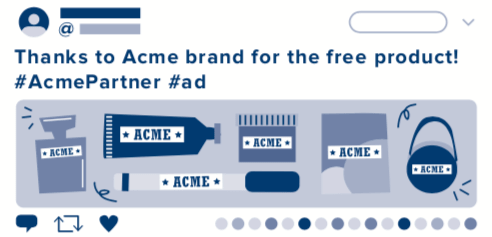The Federal Trade Commission (FTC) has issued updated guidelines for disclosing paid sponsorships with social media influencers, and marketers need to pay attention. Luckily, they’ve compiled all the information in a user-friendly guide, which you can download. Influencer marketing companies are advised to keep a copy for future reference). We’ve also compiled the most pertinent updates below – take a look!
What are the Key Takeaways?
If the FTC wants to make one thing clear with this guide, it’s this: whenever there’s a sponsorship, make it obvious. To disclose properly (which they refer to as a “good disclosure”), influencers must state their partnership in clear and simple language that’s easy to find. That means “grey-area” tactics – such as burying sponsored hashtags within a post’s comments section – will no longer fly.
Overview:
- NEW – If an influencer has a relationship with a brand, they must mention it when discussing any of their products or marketing strategies – even if those products weren’t specifically being promoted.
- NEW – Short-form disclosures such as hashtags have been expanded to include #(BRAND)Ambassador or #(BRAND)Partner, but simply stating “ambassador” or “partner” is not enough.
- NEW – Disclosures in bios are not sufficient.
- NEW – Influencers must disclose a relationship even when they were not explicitly asked to post a piece of content.
- Influencers must make a disclosure whenever there’s a relationship with a brand, which isn’t limited to monetary exchanges and includes free products and services.
- For captions, such as on Instagram, YouTube, users shouldn’t have to click to expand in order to see the disclosure. The same holds true if marketing using TikTok as an influencer strategy.
- For videos, it’s not enough to merely mention relationships inside descriptions and comment sections – they must be stated somewhere in audio and visual form within the video (preferably not at the end, where’s it’s easy to miss).
- For live videos, such as Twitch Streams, influencers should regularly mention their partnerships throughout, as users often begin viewing at different times.
It should be stated that the FTC is also trying to be flexible with their guidelines. If influencers make their partnerships hard to miss, using “simple and clear language”, they don’t even have to use commonly-accepted tactics such as things like #ad (although it helps).

In the past, how and when to disclose paid sponsorships has been somewhat of dialogue between brands and creators, which these guidelines should help simplify as influencers adopt growing marketing trends in the coming year. But more importantly, if you’re making sure to pair the right creators with the right brands, the end result is content that perfectly blends the brand’s messages with their unique voices. It’s just the natural outcome of influencer marketing done right!






